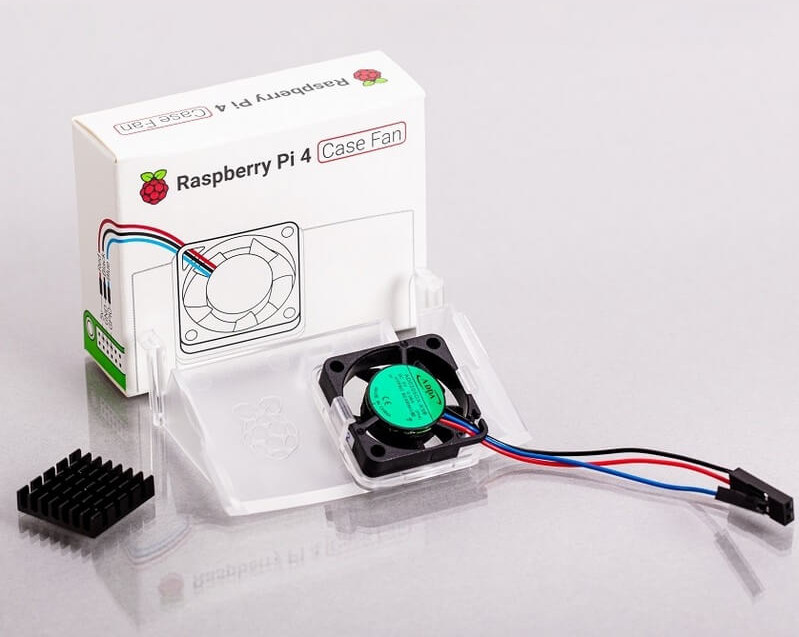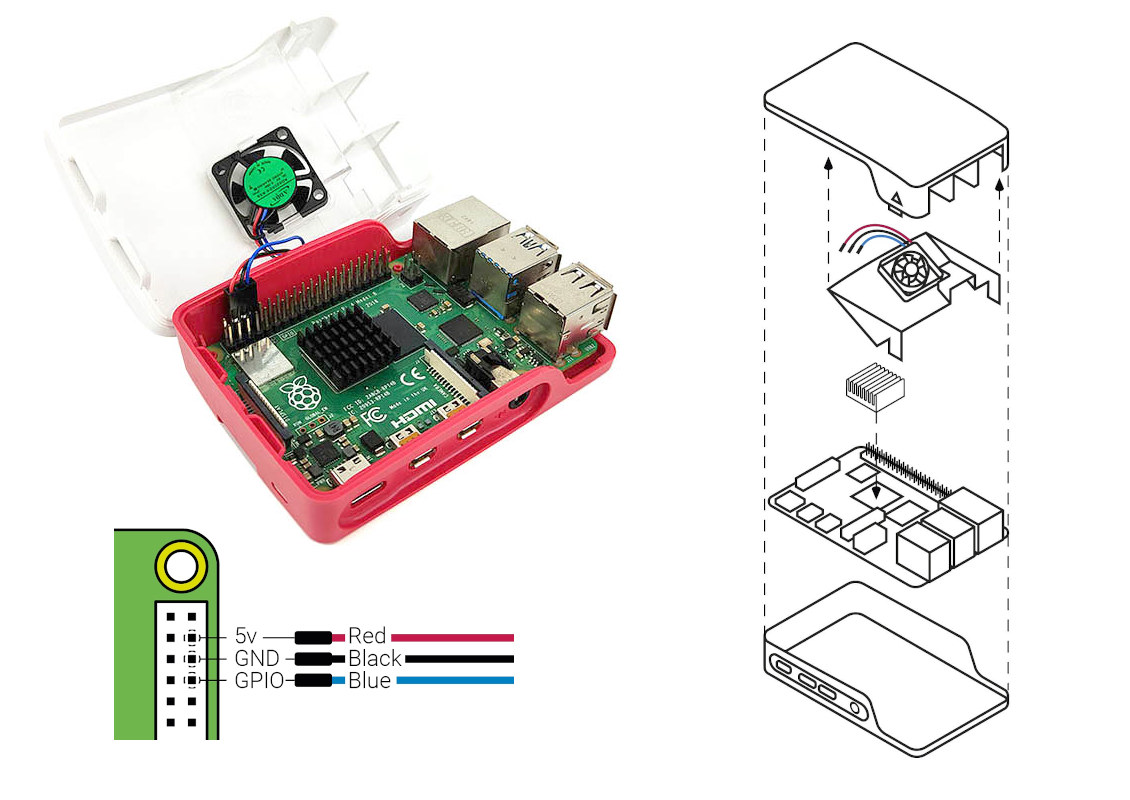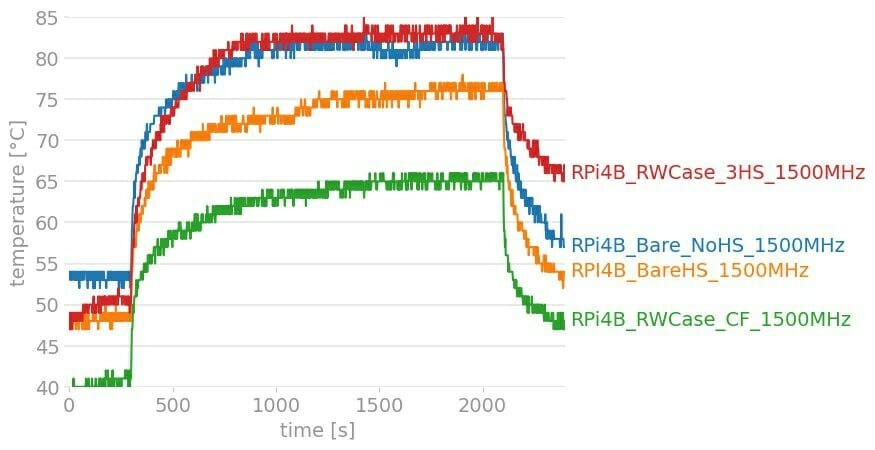When the Raspberry Pi Foundation first introduced the Raspberry Pi 4, they claimed the board would work just fine under most cases without a heatsink, and the latter was only really needed under load. That may have been true when using the board in a temperate climate like in the United Kingdom, but then Raspberry Pi 4 met Thailand with some benchmarks results lower than on a Raspberry Pi 3. People using plastic enclosures had even more troubles.
It’s only when I installed a heatsink on Raspberry Pi 4 that the board could really shine. The company also provided some firmware optimizations later on to further cool-down the board. But you can only do much with software, and many third-party cooling solutions such as fansinks or metal cases have been introduced for the popular SBC.
But it appears the Raspberry Pi Foundation is now taking cooling into account, and I was really impressed by the foundation’s latest Raspberry Pi 400 keyboard computer in that regard, as cooling is excellent, and the device should work well in any loads and conditions even in a 35-40°C room.
This brings me to today’s topic: Raspberry Pi 4 Case Fan, an official cooling kit for the Raspberry Pi 4, and the official Raspberry Pi 4 case designed for overclockers and power users.
The kit is simply comprised of an adhesive heatsink (18x18x10mm) for the Broadcom BCM2711 processor, and an add-on fan mounted to a transparent acrylic base that can snap to the official case. No screwdriver or other tools needed, and the fan is invisible from the outside.
The fan is connected to the 40-pin Raspberry Pi header and comes with 3 wires (5V, GND, and GPIO) since the blue wire is used to control the fan by software using PWM. You won’t need to mess with any settings, and updating Raspberry Pi OS to the latest version will take care of everything automatically. The case should be silent when the board handles light loads.
But how does it perform exactly? Cytron tested the Raspberry Pi 4 at the stock frequency (1.5 GHz) with different cooling solutions:
- Red – Raspberry Pi 4 Model B with 3 small heatsinks covering the CPU, RAM, and USB Controller in the official case (Red/White), and no additional fan
- Blue – Raspberry Pi 4 Model B without any cooling nor enclosure
- Orange – Raspberry Pi 4 Model B with 3 small heatsinks without an enclosure
- Green – Raspberry Pi 4 Model B fitted with the case fan kit including the heatsink on CPU, and the add-on case fan fitted to the official case (Red/White).
The official case with the official fan performs very well never exceeding 66C using StressBerry. The first two tests with heatsink plus enclosure or the barebone board will make the Raspberry Pi 4 throttle pretty quickly. Cooling looks to be sufficient with the three small heatsinks and no case, but if you like to keep your Raspberry Pi 4 board in the official case, the case fan kit will certainly help.
The Raspberry Pi 4 case fan sells for $5 plus taxes and shipping. It can be purchased standalone or as part of a kit with the official Raspberry Pi 4 case and the board via distributors including Cytron, Newark, Amazon, Pimonori, and many others.

Jean-Luc started CNX Software in 2010 as a part-time endeavor, before quitting his job as a software engineering manager, and starting to write daily news, and reviews full time later in 2011.
Support CNX Software! Donate via cryptocurrencies, become a Patron on Patreon, or purchase goods on Amazon or Aliexpress








Those Adda fans are so noisy. Tested a few little fans like that some years ago and they’re all so noisy.
That’s why the enclosure has neither intakes nor exhaust so the fan is less embarrassing while warming up all internals evenly. If the SoC thermal sensor reports e.g. constant 70°C you can be assured all other components inside and the SD card being north of 50°C 😉
Just plug it in the 3.3V pin instead.
Heh! even a 1-2 $ fan from ali has good affect!
here, my comparison test with a fan and without on rpi-3:
https://www.timg.pro/index.php/2020/11/19/raspberry-pi-fan-performance/
You need to enable the fan driver in performance settings to be able to control the pwm fan. If not, it just run at max speed.
Or run it at 3.3v on the header pin
Just noticed… where the exhaust ? The fan brings in cold air, where the warm air get out from ?
Posted the same question on https://www.raspberrypi.org/. But the moderator did not approve. LOL. In addition, there is no input holes for cold air. So the fan does not brings cold air in, as I previously thought.
I believe that this case need adjustments to get better results – holes for cold air input and exhaust for hot air.
The Pi4 runs at 65C under load. Adjustments may lead to lower temperature, but why bother?
Why didn’t the admin of raspberrypi.org just say that? weird.
They also have a chart in the announcement. Theirs temperature is a little higher than for Cytron but still under 70C
Agreed, but why to delete my comment? I wish someone will buy this case add few holes, and measure temperature over time to see what the difference
Your comments are not deleted, I can still see two comments on Raspberry Pi blog.
Yes the comments are there, with an adequate response
> add few holes
With a fan in that position drilling in some random holes somewhere won’t change much. The fan will warm up all the internal space evenly so the whole plastic enclosure can somewhat dissipate heat away in all directions.
Would be more interesting to place a 2nd thermal sensor somewhere inside and watch how those temperatures evolve over time when the SoC’s thermal sensor reports a constant high temperature since being under load for some time.
It just recirculates the air inside the case, allowing the entire case to more uniformly dissipate heat. That being said, an air in and out vent would have been more effective, but it would also have introduced more dust.
According to the official blog, it exhausts out of the gap where the microSD card slot is. I’m sure someone will claim that reduces microSD longevity, and they might be right for all I know.
Alternatively, mutilate the top of the plastic case with a drill?
Funny,
They don’t even need a heat sink, if they’re running a fan. Just a 5v 40mm fan, blowing straight on the cpu, at 3.3V, gives sufficient cooling.
I wonder if we will ever see an official metal heatsink case from RPi Trading. Although they nicely link to Flirc in the blog post announcing this fan.